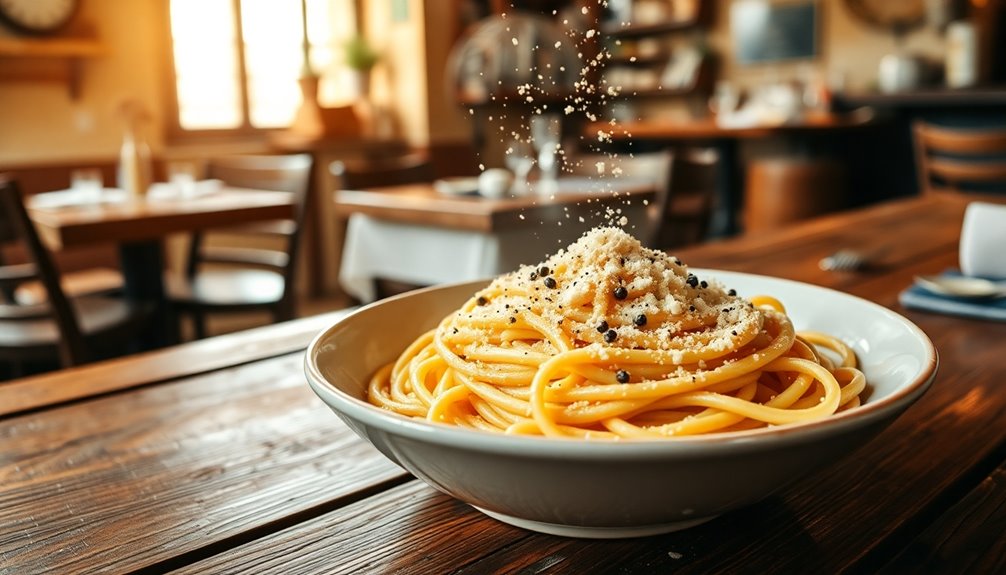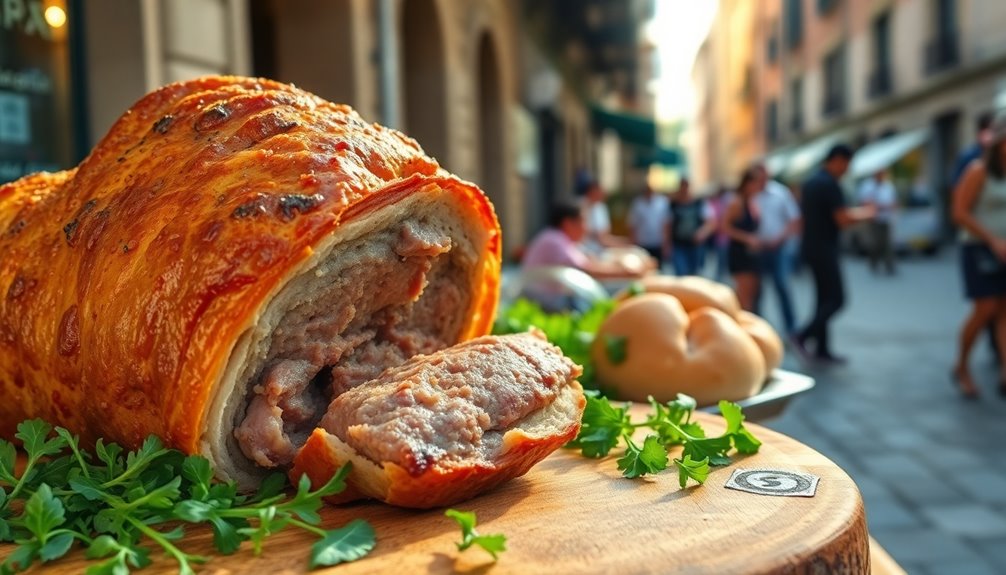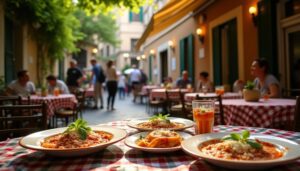Ready to taste the heart and soul of Rome? Authentic Roman cuisine bursts with flavors like carbonara and cacio e pepe that showcase fresh local ingredients. Check out bustling markets like Campo de’ Fiori for seasonal produce, and don’t miss classic trattorias for mouthwatering dishes like saltimbocca and amatriciana. Immerse yourself in food tours to explore culinary gems and meet local chefs who share their secrets. Stick around to uncover even more tasty adventures waiting for you!
Overview of Roman Cuisine
When you think of Roman cuisine, it’s hard not to get excited about the rich flavors and vibrant history that come together on every plate.
Roman food is a delightful blend of simplicity and tradition, showcasing local ingredients and culinary traditions that have stood the test of time. You’ll find classic dishes like pasta alla carbonara and cacio e pepe, each with its own story to tell.
Dining in Rome isn’t just about eating; it’s an experience that connects you to the city’s heart and soul. While exploring the charming streets, you’ll discover cozy trattorias and bustling markets where you can savor authentic flavors. One of the best ways to immerse yourself in this culinary culture is to indulge in Italian culinary delights that represent the region’s heritage.
Embrace the culinary heritage of Rome, and let each bite take you on a delicious journey.
Traditional Ingredients of Lazio
When you think about traditional ingredients of Lazio, you can almost taste the vibrant flavors of the region!
From fresh local produce like artichokes and tomatoes to pantry staples that form the backbone of Roman dishes, each ingredient tells a story.
Let’s explore what makes these essentials so special and how they can elevate your cooking! The region’s culinary diversity reflects its rich history, making it a top destination for food enthusiasts.
Key Local Produce
Exploring the vibrant flavors of Lazio is like starting a culinary treasure hunt, where each ingredient tells a story of tradition and passion.
You’ll find that local farms in the region are brimming with seasonal produce, from ripe tomatoes to crisp artichokes, all bursting with flavor. These fresh ingredients are the backbone of authentic Roman dishes, bringing a taste of the countryside to your plate.
When you visit markets like Campo de’ Fiori, you can chat with farmers about their harvests, ensuring you’re choosing the best quality. Enjoying these local treasures not only delights your palate but also supports sustainable practices.
Essential Pantry Staples
After savoring the local produce at bustling markets, it’s time to stock up on the traditional ingredients that form the heart of Roman cooking.
Begin with essential herbs like basil, oregano, and rosemary, which add that unmistakable flavor to your dishes.
Don’t forget traditional oils, particularly high-quality extra virgin olive oil, which is a staple in every Roman kitchen.
As you explore local shops, look for artisanal versions that enhance your meals safely and deliciously.
By incorporating these pantry staples, you’re not just cooking; you’re experiencing the authentic taste of Lazio.
So grab your basket and enjoy the adventure of gathering these necessities, ensuring your culinary journey is both safe and flavorful.
Happy cooking!
Classic Dishes to Try
Have you ever wondered what makes Roman cuisine so irresistibly delicious? When you visit Rome, you can’t miss trying classic dishes like *Cacio e Pepe*—a simple yet flavorful pasta that highlights the importance of quality ingredients.
Another must-try is *Saltimbocca alla Romana*, a delightful dish that showcases the cultural significance of Roman cooking traditions.
Remember, dining etiquette matters here, so savor every bite and enjoy your meal leisurely. Pair your dish with a local wine for an authentic experience. Additionally, for families traveling with kids, consider bringing along engaging travel accessories to keep them entertained during your culinary adventures, such as creative activity toys that can enhance the dining experience.
Don’t hesitate to ask locals for their favorite spots; they often know hidden gems that tourists might overlook. Embrace the flavors and traditions, and you’ll create memories that last a lifetime!
Carbonara: The Roman Staple
If you think Roman cuisine can’t get any better, wait until you try *Carbonara*! This iconic dish has a rich history, often debated among food lovers. Made with simple ingredients, it’s a delightful blend of flavors that’ll leave you wanting more.
When savoring Carbonara, consider these variations:
- Guanciale vs. Pancetta: Traditional recipes use guanciale, while some opt for pancetta.
- Egg Styles: Some chefs prefer using whole eggs, while others stick to egg yolks for creaminess.
- Cheese Choices: Pecorino Romano is a must, but some add a hint of Parmesan for a twist.
You’ll find Carbonara in many Roman trattorias, each offering their unique take. Additionally, many of these trattorias are located near popular tourist attractions, making them ideal for budget-conscious travelers looking to enjoy authentic cuisine.
Enjoy this culinary adventure while feeling safe and satisfied!
Cacio E Pepe: Simplicity at Its Best

Cacio e Pepe is one of those dishes that proves simplicity can be incredibly satisfying. Originating from the ancient Roman shepherds, this delightful pasta dish blends just three ingredients: spaghetti, Pecorino Romano cheese, and black pepper.
You’ll be amazed at how something so simple can create an explosion of flavor! When you visit Rome, make sure to indulge in this classic at a local trattoria. The creamy cheese and pepper sauce cling perfectly to the pasta, making each bite a comforting experience.
Don’t be surprised if you find yourself craving it again and again! So, whether it’s your first time or a return visit, cacio e pepe is a must-try for a taste of Rome’s culinary history. Enjoy! Additionally, consider exploring last-minute travel deals to make your trip to Rome even more enjoyable and affordable.
Amatriciana: A Flavorful Journey
Get ready to savor the rich flavors of Amatriciana, a dish that’s sure to take your taste buds on an unforgettable journey!
We’ll explore its essential ingredients, share some cooking techniques, and highlight the best places in Rome to enjoy this classic meal.
You won’t want to miss the chance to experience this culinary delight firsthand! Additionally, consider bringing along travel accessories for women to enhance your culinary adventure in the city.
Ingredients of Amatriciana
When you think of Italy, the rich flavors of Amatriciana might just dance in your mind, tempting your taste buds with every thought.
This classic dish has a fascinating history and boasts several delicious variations. The key ingredients come together to create a mouthwatering experience you’ll never forget:
- Guanciale: This cured pork cheek gives Amatriciana its distinctive flavor.
- Pecorino Romano: A sharp, salty cheese that enhances the dish’s richness.
- Tomatoes: They provide a fresh, vibrant base that brings everything together.
With each bite, you’ll savor the essence of Lazio.
Whether you’re enjoying a traditional version or exploring Amatriciana variations, this dish is a must-try during your Roman culinary adventure.
Safe travels and happy eating!
Cooking Techniques Explained
As you commence your culinary journey to master Amatriciana, understanding the cooking techniques is essential to capturing its authentic flavors.
Start by employing simmering techniques to slowly develop the sauce, allowing the tomatoes to meld beautifully with the guanciale. This method enhances the richness and depth of the dish.
Next, consider roasting methods for the guanciale. By roasting it until crispy, you’ll achieve a delightful texture that complements the soft pasta.
Don’t rush; give each step the time it deserves. Remember, cooking is about patience and passion!
As you stir and savor, envision yourself in the heart of Rome, enjoying every bite of this classic dish. You’re not just cooking; you’re creating a flavorful journey!
Best Restaurants in Rome
After mastering the cooking techniques for Amatriciana, it’s time to explore where you can enjoy this delightful dish in its true Roman form.
You’ll find that Rome is brimming with fantastic dining experiences that celebrate its culinary traditions. Here are three top spots you shouldn’t miss:
- Trattoria Da Enzo al 29: Known for its authentic flavors, this cozy eatery serves up a classic Amatriciana that’ll have your taste buds dancing.
- Piperno: This historic restaurant offers a rich version of the dish, paired with a lovely ambiance.
- La Carbonara: A favorite among locals, here you’ll savor a delicious Amatriciana made with high-quality ingredients.
Enjoy your culinary journey through Rome, and don’t forget to soak in the atmosphere!
Saltimbocca Alla Romana: a Culinary Delight
If you’re dreaming of a culinary adventure in Rome, Saltimbocca Alla Romana is a dish you simply can’t miss.
This classic dish features tender veal, wrapped in prosciutto, and enhanced with fresh sage. The cooking methods bring out the rich, savory flavors, making each bite a delightful experience.
You’ll appreciate the way the meat is pan-seared, allowing the flavors to meld beautifully. The flavor profiles are a perfect balance of salty and aromatic, leaving you craving more.
When you try it at a local trattoria, you’ll feel the warmth of Roman hospitality. Don’t forget to pair it with a glass of Roman wine for the ultimate experience. To enhance your travels, consider packing travel accessories to make your journey more convenient.
Safe travels and happy eating!
Porchetta: The Iconic Roman Street Food

Once you’ve savored the deliciousness of Saltimbocca Alla Romana, it’s time to explore another iconic favorite—Porchetta!
After enjoying the delectable Saltimbocca Alla Romana, dive into the iconic flavors of Porchetta!
This succulent, roasted pork is a staple in Roman street food and boasts a rich history that dates back centuries. The porchetta preparation involves seasoning a whole pig with herbs and spices, then slow-roasting it until the skin is crispy and the meat tender.
When you’re in Rome, don’t miss trying porchetta from these local spots:
- Panzirone: Famous for its juicy, flavorful sandwiches.
- Porchetta di Ariccia: A must-visit for authentic flavors.
- Trapizzino: Where you can enjoy porchetta in a unique pocket-style bread.
Each bite of porchetta is a delicious journey through Roman culinary tradition! Additionally, you might want to explore Rick Steves Italy, which provides insights into the best local dishes and dining experiences in Rome.
Artichokes: A Seasonal Favorite
When you find yourself wandering the charming streets of Rome in spring, you can’t miss the vibrant artichokes that take center stage in the city’s culinary scene.
These delightful vegetables come in several artichoke varieties, each offering a unique taste and texture. One of the most popular is the Carciofo Romano, known for its tender leaves and rich flavor.
Don’t miss seasonal recipes like “Carciofi alla Romana,” where artichokes are braised with herbs, or “Fried Artichokes,” a crispy street food favorite.
You’ll find them in local markets and trattorias, where chefs prepare them fresh and delicious. Additionally, be sure to try dishes that pair well with travel comfort accessories to enhance your culinary experience while exploring Rome.
Roman Pizza: Styles and Variations
As you stroll through the bustling streets of Rome, the tantalizing aroma of fresh pizza wafts through the air, beckoning you to indulge in one of the city’s most beloved culinary treasures.
Roman pizza comes in various styles, each offering a unique experience. You’ll want to try:
Roman pizza offers a delightful variety of styles, each promising a unique and unforgettable culinary experience.
- Neapolitan Pizza: Thin, soft, and topped with fresh ingredients, it’s a classic that melts in your mouth.
- Sicilian Pizza: Thick and rectangular, this style boasts a crunchy crust and generous toppings, perfect for sharing.
- Pizza al Taglio: Sold by the slice, this street food favorite is great for a quick bite as you explore.
Whichever style you choose, you’re in for a delightful treat that captures the heart of Roman cuisine!
Best Local Markets for Authentic Ingredients
Imagine wandering through the vibrant streets of Rome, where every corner reveals a treasure trove of fresh, local ingredients just waiting to be discovered!
Start your culinary adventure at Campo de’ Fiori, bustling with local vendors offering everything from ripe tomatoes to fragrant herbs.
Don’t miss the Testaccio Market, where you can sample authentic products while chatting with passionate vendors enthusiastic to share their knowledge.
For a deeper dive, consider joining a market tour, guiding you through Rome’s best spots while ensuring your safety.
You’ll gain insights into selecting the finest ingredients, all while soaking up the lively atmosphere.
With every visit, you’ll feel the heart of Roman cuisine come alive!
Top Restaurants to Experience Roman Cuisine
If you’re ready to savor the true flavors of Rome, you’ve got to check out some of the city’s top restaurants that serve traditional dishes.
From mouthwatering carbonara to crispy supplì, these iconic dining spots will take your taste buds on an unforgettable journey.
Get ready to experience the heart of Roman cuisine in a way that’ll leave you craving more!
Traditional Dishes to Try
When you step into the vibrant streets of Rome, the tantalizing aromas wafting from local eateries beckon you to immerse yourself in the city’s rich culinary landscape.
You’ll want to savor the traditional dishes that highlight the area’s culinary traditions and regional flavors.
Don’t miss out on these must-try dishes:
- Carbonara: A creamy pasta dish with eggs, cheese, pancetta, and pepper.
- Cacio e Pepe: Simple yet delicious pasta tossed with cheese and black pepper.
- Saltimbocca alla Romana: Tender veal wrapped in prosciutto and sage, cooked to perfection.
These dishes offer a taste of Rome’s heart and soul, so plunge into and let your taste buds explore!
Safe travels and happy eating!
Iconic Dining Establishments
After savoring those traditional Roman dishes, the next step in your culinary adventure is to visit the city’s iconic dining establishments.
You can’t miss the classic trattorias, like Trattoria Da Enzo, where you’ll find mouthwatering cacio e pepe served in a cozy atmosphere.
For a delicious pizza experience, head to famous pizzerias like Pizzeria Ai Marmi, known for its crispy, thin crusts and vibrant toppings.
These places not only offer great food but also a warm, inviting vibe that makes you feel right at home.
Just remember to check for safety measures in place, ensuring you enjoy every bite worry-free.
Food Tours: Discovering Lazio’s Culinary Scene
As you wander through the charming streets of Lazio, you’ll discover that food tours are one of the best ways to immerse yourself in the region’s rich culinary scene.
With expert guides leading the way, you’ll enjoy safe and delightful food tastings that showcase local flavors. Here are a few highlights you can expect:
- Explore traditional markets where fresh ingredients come alive.
- Sample authentic dishes, from pasta alla carbonara to supplì.
- Meet local chefs who share their culinary experiences and stories.
These tours not only satisfy your taste buds but also provide a deeper understanding of Lazio’s food culture.
Some Questions Answered
What Are the Dining Etiquette Rules in Traditional Roman Restaurants?
When dining in traditional Roman restaurants, mind your dining customs. Keep your voice moderate, respect personal space, and avoid rushing. Good restaurant behavior includes waiting for the server and appreciating the meal’s authenticity. Enjoy your experience!
Are There Vegetarian Options Available in Roman Cuisine?
Yes, you’ll find vegetarian options in Roman cuisine. Look for dishes featuring traditional ingredients like artichokes and seasonal vegetables. Many restaurants offer vegetarian specialties, ensuring you can enjoy safe, delicious meals without meat.
How Does Lazio’s Cuisine Differ From Other Italian Regions?
You might be surprised how Lazio’s cuisine stands apart. Its specialties highlight regional ingredients like artichokes and guanciale, offering a rustic charm that’s distinct from the more refined dishes found in northern Italy. Enjoy the difference!
What Desserts Should I Try Alongside Roman Dishes?
When enjoying Roman dishes, consider dessert pairings like tiramisu or panna cotta. Don’t miss traditional pastries such as maritozzi, which are delightful and safe choices to satisfy your sweet tooth after a savory meal.
Can I Find Gluten-Free Options in Roman Cuisine?
Absolutely, you’ll find gluten-free options in Roman cuisine. For instance, many restaurants offer gluten-free pasta made from alternative grains like rice or corn, ensuring you can enjoy traditional flavors safely without compromising your dietary needs.







